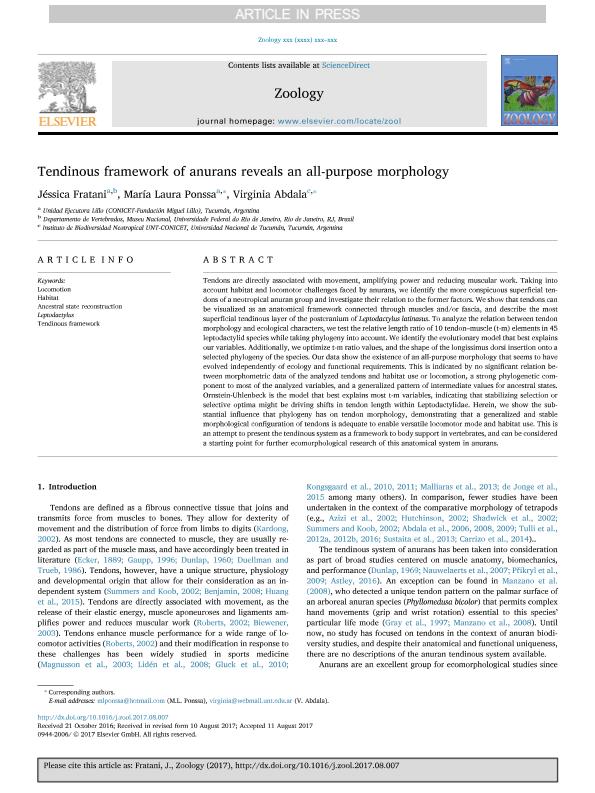Mostrar el registro sencillo del ítem
dc.contributor.author
Fratani Da Silva, Jéssica

dc.contributor.author
Ponssa, María Laura

dc.contributor.author
Abdala, Virginia Sara Luz

dc.date.available
2018-09-04T17:54:43Z
dc.date.issued
2018-02
dc.identifier.citation
Fratani Da Silva, Jéssica; Ponssa, María Laura; Abdala, Virginia Sara Luz; Tendinous framework of anurans reveals an all-purpose morphology; Elsevier Gmbh; Zoology; 126; 2-2018; 172-184
dc.identifier.issn
0944-2006
dc.identifier.uri
http://hdl.handle.net/11336/58257
dc.description.abstract
Tendons are directly associated with movement, amplifying power and reducing muscular work. Taking into account habitat and locomotor challenges faced by anurans, we identify the more conspicuous superficial tendons of a neotropical anuran group and investigate their relation to the former factors. We show that tendons can be visualized as an anatomical framework connected through muscles and/or fascia, and describe the most superficial tendinous layer of the postcranium of Leptodactylus latinasus. To analyze the relation between tendon morphology and ecological characters, we test the relative length ratio of 10 tendon–muscle (t-m) elements in 45 leptodactylid species while taking phylogeny into account. We identify the evolutionary model that best explains our variables. Additionally, we optimize t-m ratio values, and the shape of the longissimus dorsi insertion onto a selected phylogeny of the species. Our data show the existence of an all-purpose morphology that seems to have evolved independently of ecology and functional requirements. This is indicated by no significant relation between morphometric data of the analyzed tendons and habitat use or locomotion, a strong phylogenetic component to most of the analyzed variables, and a generalized pattern of intermediate values for ancestral states. Ornstein-Uhlenbeck is the model that best explains most t-m variables, indicating that stabilizing selection or selective optima might be driving shifts in tendon length within Leptodactylidae. Herein, we show the substantial influence that phylogeny has on tendon morphology, demonstrating that a generalized and stable morphological configuration of tendons is adequate to enable versatile locomotor modes and habitat use. This is an attempt to present the tendinous system as a framework to body support in vertebrates, and can be considered a starting point for further ecomorphological research of this anatomical system in anurans.
dc.format
application/pdf
dc.language.iso
eng
dc.publisher
Elsevier Gmbh

dc.rights
info:eu-repo/semantics/openAccess
dc.rights.uri
https://creativecommons.org/licenses/by-nc-nd/2.5/ar/
dc.subject
Ancestral State Reconstruction
dc.subject
Habitat
dc.subject
Leptodactylus
dc.subject
Locomotion
dc.subject
Tendinous Framework
dc.subject.classification
Otras Ciencias Biológicas

dc.subject.classification
Ciencias Biológicas

dc.subject.classification
CIENCIAS NATURALES Y EXACTAS

dc.title
Tendinous framework of anurans reveals an all-purpose morphology
dc.type
info:eu-repo/semantics/article
dc.type
info:ar-repo/semantics/artículo
dc.type
info:eu-repo/semantics/publishedVersion
dc.date.updated
2018-08-30T13:32:17Z
dc.journal.volume
126
dc.journal.pagination
172-184
dc.journal.pais
Alemania

dc.description.fil
Fil: Fratani Da Silva, Jéssica. Consejo Nacional de Investigaciones Científicas y Técnicas. Centro Científico Tecnológico - Tucumán. Unidad Ejecutora Lillo; Argentina. Universidade Federal do Rio de Janeiro; Brasil
dc.description.fil
Fil: Ponssa, María Laura. Consejo Nacional de Investigaciones Científicas y Técnicas. Centro Científico Tecnológico - Tucumán. Unidad Ejecutora Lillo; Argentina
dc.description.fil
Fil: Abdala, Virginia Sara Luz. Consejo Nacional de Investigaciones Científicas y Técnicas. Centro Científico Tecnológico Conicet - Tucuman. Instituto de Biodiversidad Neotropical. Universidad Nacional de Tucuman. Facultad de Ciencias Naturales e Instituto Miguel Lillo. Instituto de Biodiversidad Neotropical. Instituto de Biodiversidad Neotropical; Argentina
dc.journal.title
Zoology

dc.relation.alternativeid
info:eu-repo/semantics/altIdentifier/doi/http://dx.doi.org/10.1016/j.zool.2017.08.007
dc.relation.alternativeid
info:eu-repo/semantics/altIdentifier/url/https://www.sciencedirect.com/science/article/pii/S094420061630126X
Archivos asociados
